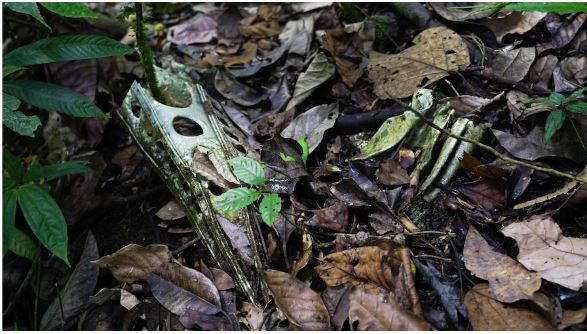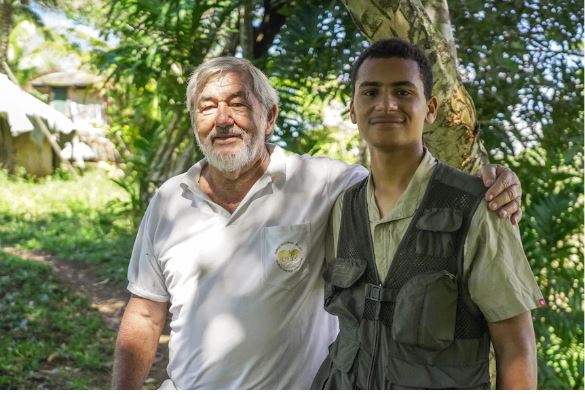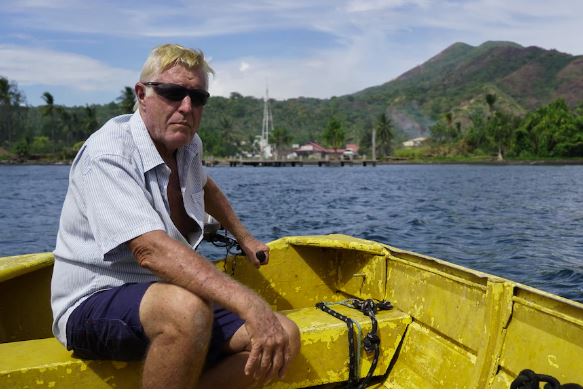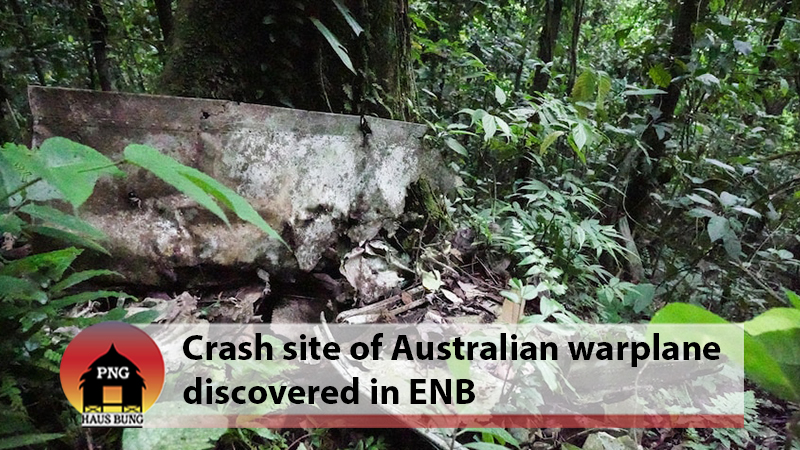It’s been around 80 years since the plane it was attached to crashed.
The aircraft and the four men believed to have been onboard have lain here since, undiscovered.
It’s estimated there are between 500 and 600 crash sites across PNG from World War II, but the locations of many of them remain unknown.
After this discovery, there will be one less Australian plane considered missing in action.
The long jungle trek to discover a wreck
The tip-off first came from a pig hunter who stumbled across the wreckage while tracking his prey.
It was up in the hills of East New Britain, outside the town of Rabaul where Willie’s family lives.

But getting to the site to investigate wasn’t easy.
“I collapsed on the way in, so it was pretty tough for me,” Willie says.
He blames himself for not eating enough before beginning the trek.
“And all the river crossings going to the crash site, it was brutal, I ended up going back with a sprained ankle.
“But it was all worth it.”
He went in with a group of family friends. They were hosted by the chief of the nearest village, Barrum, with some of the villagers accompanying the group to the site.

From the village, it takes several hours of trekking to get to the site: through the bush, across several rivers and up and down multiple mountain sides.
For one stretch of the walk, the group used the river as their path, walking through the water for several hundred metres to reach the next point to climb.
They used machetes to cut a rough path through the jungle as they went.
Then they came across the first piece of metal debris.
“I was going nuts, I went bananas. I said, ‘No way, what is this bit of metal doing in the middle of the jungle?’,” Willie recounts.
Pieces of the plane are scattered across the hillside. Some parts look like scrap metal, but others are clearly identifiable: part of a propeller, a bit of a door, several guns.

Willie and his crew had to dig to discover much of the plane which had been buried in decades of mud.
“What helped identify that aircraft was a Beaufort control column,” Willie says.
“It was in the cockpit area, which was underground by about three metres maybe, so we dug down and took out the control column.”
The group could also see bones of the men who had been onboard, parts of a leather watch and the pilot’s vest.

The volunteers piecing together war history
Willie brought the control column and some of the rusted weaponry back to his father David Flinn to try to identify the plane.
David is president of the Rabaul Historical Society and the reason Willie has such an interest in WWII history.
“I used to follow him out to investigate leads that others would provide for him, and we would go and see crash sites,” Willie says of his childhood.

Rabaul was a significant site during the war. Guarded by a small contingent of Australian troops, it was captured by Japanese forces in 1942 and turned into a major naval and air military base.
It then suffered intense allied bombing until the end of the war.
Across Rabaul, huge tunnels still remain that were dug by the Japanese — largely using forced labour — to hide people and materials from the air strikes.
Over on the main island of New Guinea in East Sepik province, the US Embassy recently carried out their own excavations to repatriate the remains of WWII soldiers.

David is among a small group of locals who volunteer to preserve the history and discover crash sites in Rabaul.
He’s glad to see his son take on the interest.
“It’s extremely important because people like us, we’re at the end of our careers. I can’t walk up into the bush like I used to,” he says.
Rod Pearce, another local and an experienced diver, has identified more than 50 crash sites — mostly underwater.

Many families have come to Rod for help in locating relatives who were lost during the war.
“I always reply but in a lot of cases it’s beyond me to even start a search, and a lot of times they don’t know where he went down,” he explains, sitting on his boat in Rabaul Harbour.
But Rod has been able to assist many families, as well as authorities from the US, Australia, and Japan, in locating sites.
It involves extensive research, planning, and trawling through records.
“Some of the aircraft still have [people listed as missing in action] onboard, waiting for the authorities to do the recoveries. And that’s what I like [to see] — to just see closure for those airmen from WWII,” he says.
‘The plane was shot at’: Villagers share stories of the downed aircraft
The memories of the war have also been passed down in many villages across East New Britain.
“Stories of the war were passed down from generation to generation,” Barrum village chief Israel Joseph says.
“During the war, the Japanese had killed some of locals.
“Others were used as carriers, some died because of carrying heavy loads.”
He came across the crash site that Willie is now studying 15 years ago. He says he has heard stories of the plane being shot down.
“It flew that way and crashed over there. My grandfather told me this. They watched the plane crash land from the old Vunga village.”
The chief has protected the site and was glad to see Willie come to document and report it, but he’s worried about people from a neighbouring village coming onto his land to try to steal parts of the plane.

David Flinn says many crash sites are lost to people pillaging.
“The single-biggest problem we have is that people believe that these wrecks are very valuable,” he says.
“So, they go up and smash the site to bits and by the time we get to hear about them there’s usually not a lot left.”
There is also concern about sites being destroyed by logging companies.
Identifying the plane — and the Australians onboard
It’s been a year since Willie first trekked out to the plane site. He recently returned to try to get more identifying information.
David and Rod are working on the guns he brought back from the first trip, trying to clean them up and find serial numbers.
On his second visit to the site, Willie was trying to find identifying numbers on the props and other parts of the wreckage, but the material was either too rusted or buried.
Willie remains hopeful that the plane can be identified.
“It would mean the world to me,” he says.

The team has so far been able to identify the aircraft as an Australian Beaufort, and based on records of that type of plane and the area it was found in, the team believes there are two likely options.
“It could be one of two — I wouldn’t like to speculate who it is, simply because we haven’t done enough investigation on it yet and it could take another year before we really find out who is in there,” David says.
Also, they think four airmen would have been onboard, based on the type of plane.
The Australian Defence Force was informed when the site was found last year, but they haven’t been out to visit yet, so there hasn’t been an official identification.
“In light of the eased COVID-19 related travel restrictions, further investigation of this remote crash site is planned in 2023,” a spokesperson said in a statement.
There is a small team within the Royal Australian Air Force tasked with investigating wreckages like this one.
The defence spokesperson said RAAF has provided guidance to minimise disturbance to the site to ensure the best chance of positively identifying the aircraft and recovering any human remains.
“Defence is committed to the recovery, identification and burial of its men and women who died while serving their nation,” the statement said.
David says he’s hopeful the authorities will soon be able to make the trip, in order to finally bring closure to the families of those who went down with the plane.
Source: ABC Pacific News

